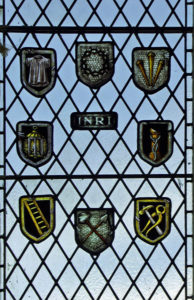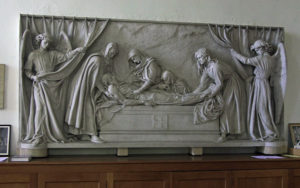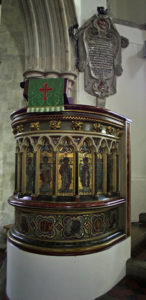St Leonard’s Church is set high above the lovely old town of Hythe and visually it is virtually unchanged since the C14th when Hythe was an important Cinque port as well as being on the pilgrim route to Canterbury Cathedral.
It is also one of only two churches in England to have an ossuary and contains one of the largest and best preserved collection of bones and skulls in Britain. I had to visit!
Hythe had been an important Roman port. The sea came up to the edge of the present High Street which was a busy quay side. There has been a church here in Saxon times. After the Norman Conquest, the Normans built a church next to it in 1080, retaining the Saxon church which was used by the Jurats (councillors) for their meetings.
The town prospered and the church was extended in 1120 with side aisles, south transept and the original Saxon church, know known as St Edmund’s Chapel, became the north transept. After the murder of Thomas Beckett, pilgrims from across Europe arrived at Hythe Harbour on their way to Canterbury, stopping in the church to give thanks for their safe crossing.
The Norman apse was replaced by a larger chancel and an ambulatory (inaccurately referred to as the crypt) was built under the chancel so that the priest and his flock could progress on Holy Ground round the church. This later became the ossuary.
Hythe’s fortunes declined as the harbour silted up, the Black Death and fall in pilgrim numbers after the Reformation. The tower collapsed in 1739 and was rebuilt in the same style reusing many of the original stones. By the C19th the church was in poor condition and the parishioners raised £10,000 for its restoration by GE Street and John Pearson. They built a new chancel roof, replaced the roof in the nave and added stained glass windows. The Victorian work can be immediately recognised as they used a sand coloured stone rather than the pale Caen stone of the original building.
Inside it is a large church and even on a bright sunny day was quite dark inside. An arcade of pointed arches separates the nave from the side aisles. High on the north wall can be seen the remains of the original Norman windows. There is a lovely Norman arch from the 1120 church in the south aisle. Beyond it is the later pointed Gothic arch from the 1200 extension.
The font at the back of the church is C14th although is on a C19th stand. The pulpit was originally a simple wooded structure designed by GE Street, but once installed was thought to be too plain. Mosaic designs were added later with panels on sale for £8 each.
St Edmund’s Chapel in the North Transept is the original Saxon church. It still has a Saxon archway in the west wall which would have been the original entrance to the church. It is worth going into the C210th Choir vestry to admire the other side of the Saxon door. This is Norman dating from 1180 and has carved capitlas and arches.
On the south wall of the church is a lovely carving by GE Street, made from a single block of Carrera marble and showing the body of Christ being placed in the tomb.
A flight of steps leads up to the chancel, with more to the sanctuary. This has been described as one of the finest of any parish church in England with its triforium and clerestory. It looks more suited to a cathedral than a parish church.
The stained glass east window dates from 1951. The Victorian glass was blown out by a bomb in 1940. It was designed by a local artist and the bottom left had panel has a Cinque port ship. The bottom right hand panel has an anti-aircraft gun and a searchlight.
On either side are small chapels with unusual modern altar fronts made from leather. That in the north chapel has the white cliff of Dover.
The stained glass is modern as the glass was blown out by a bomb in 1940. There are small fragments of medieval glass in the south chapel which were discovered when the north door to the ossuary was excavated in the late C19th.
The Ossuary or Bone House is reached from a doorway on the outside east wall of the church. Although it is referred to as the crypt, it was originally built as an ambulatory, not a crypt. It is open twice a day but although I had checked opening times before visiting, it was firmly locked when I arrived and I couldn’t find anyone with a key.
Ossuaries were once common in parish churches and were used to house the bones of dead dug up from the churchyard. Bodies were only left in the ground for a short time, just long enough for the flesh to rot, before being dug up to make way for further burials. The skull and femurs were kept as it was thought this would guarantee safe passage to the after life.
There are over 4000 bodies stored here, mainly from the C13th. The skulls are carefully arranged on shelves and the rest of the bones stored in a neat pile nearly to the ceiling. There is more information “here”:http://www.bbc.co.uk/news/uk-england-18396901 and pictures “here.”:https://www.flickr.com/photos/ilike/sets/72157617398695952/
Even though I wasn’t able to get into the ossuary, the rest of the church was well worth visiting. It is a lovely church. The church is open daily from 9-5. The Ossuary or crypt is open 11-1 and 2-4 everyday except on Sunday mornings. There is car parking space available by the church. The post code is CT21 5DN and the grid reference is
TR 161349.
There are more of my pictures “here.”:http://wasleys.org.uk/eleanor/churches/england/south/southeast/hythe/index.html










